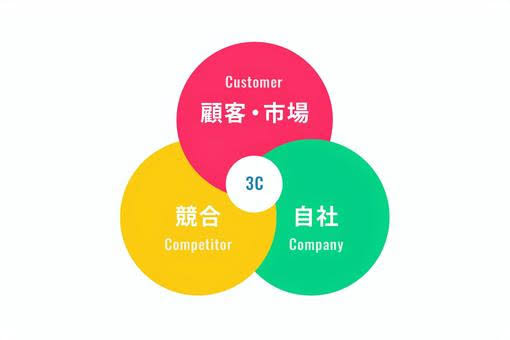In a fiercely competitive business environment, strategic information gathering and analysis are indispensable for success. Comparing against competitors and understanding market trends are key elements that significantly impact the success or failure of a business. This article focuses on the powerful tool of ‘Competitor Analysis,’ detailing how to comprehend competitors’ strategies and strengthen one’s own business. It covers fundamental concepts of competitor analysis, the utilization of specialized frameworks and tools, and specific methodologies. Additionally, it delves into the importance of competitor analysis, its effects, and detailed insights on leveraging this tool for business. Gain the crucial skills needed to triumph in the competitive landscape.
Recommended Read: ‘Understanding All About Marketing Strategies! Explaining Strategies and Methods from Basics’
1.Competitor Analysis
Competitor Analysis: Basic Concepts
Competitor analysis is a strategic process in business environments aimed at winning against other companies in the competition. This analysis focuses on the strengths and weaknesses of competitors, their market position, and how they offer products or services. The primary goal of competitor analysis is to refine one’s own strategies and establish an advantage over competitors.
The fundamental elements of competitor analysis cover various aspects of competitors, including their vision, strategies, resources, market share, customer base, growth strategies, promotion strategies, pricing, among others. Collecting this information is necessary to understand competitors’ trends and their position in the market.
Importance and Role of Competitor Analysis
The importance of competitor analysis is particularly heightened in highly competitive and saturated business environments. Conducting accurate and comprehensive competitor analysis fulfills the following roles:
- Strategy Improvement: Through competitor analysis, identifying errors in one’s strategies and finding directions for improvement becomes possible.
- Market Adaptation: Understanding the approaches competitors take in the market allows for actions to be taken in response.
- Discovering New Opportunities: Competitor analysis aids in discovering new market opportunities and growth points. Learning from competitors’ successes can benefit one’s own business.
- Risk Mitigation: Understanding competitors’ movements enables the anticipation of risks stemming from competition and taking preemptive measures.
2.Competitor Analysis Framework
Frameworks for Conducting Competitor Analysis
To effectively conduct competitor analysis, using specific frameworks is common. The following are primary frameworks used to advance competitor analysis:
- SWOT Analysis: SWOT analysis identifies competitors’ strengths, weaknesses, opportunities, and threats in comparison to one’s own business. This evaluation helps assess one’s competitive edge.
- Five Forces Analysis: Porter’s Five Forces analysis is a tool to evaluate the competitive environment. It focuses on competitors, substitutes, bargaining power of customers, bargaining power of suppliers, and barriers to entry.
- PESTEL Analysis: PESTEL analysis evaluates the market environment based on Political, Economic, Social, Technological, Environmental, and Legal factors. Understanding external factors affecting competitors is crucial.
Steps for Effective Competitor Analysis Using Frameworks
Effective steps for conducting competitor analysis using frameworks include:
- Data Collection: Gather information about competitors from sources such as official documents, websites, social media, product or service details, and market data.
- Information Organization: Organize collected data based on frameworks like SWOT analysis, Five Forces analysis, PESTEL analysis, etc.
- Evaluation of Competitors: Assess competitors’ strengths, weaknesses, opportunities, and threats, comparing them with one’s own business.
- Strategy Development: Based on the results of competitor analysis, devise new strategies or improvements. This may include developing new products or services, pricing strategies, sales strategies, among others.
3.Competitor Analysis Templates
What Competitor Analysis Templates Are and How They Are Useful
Competitor analysis templates are tools used to organize and visualize information for effective analysis.
1.SWOT analysis templates, for instance, record and visually represent competitors’ strengths, weaknesses, opportunities, and threats.

2.Five Forces Analysis Template: Porter’s Five Forces analysis template visually represents the competitive environment of the market and assesses the impact of each factor.

Effective Process of Competitive Analysis Using Templates
- Preparation of the Template: Select an appropriate template and gather necessary information.
- Information Input: Fill in the collected information into the template. This process provides a visual understanding of competitors’ characteristics and market situations.
- Visualization and Analysis: Visualize and analyze the entered information in the template. This step reveals the outcomes of SWOT analysis or Five Forces analysis.
- Strategy Development: Based on visualized data, devise new strategies or improvement plans. Templates assist in decision-making for strategies.
4.Recommended Competitive Analysis Tools
Various tools have been developed to efficiently conduct competitive analysis, supporting data collection, analysis, and visualization, thereby aiding in the effective progression of the competitive analysis process.
Some recommended competitive analysis tools include:
- SEMrush: Specializing in SEO competitive analysis, SEMrush offers keyword research, traffic analysis, and backlink monitoring. It provides data on competitors’ web traffic and keywords.
- Ahrefs: A tool proficient in SEO and link analysis, Ahrefs investigates competitors’ backlinks, keywords, and content performance.
- Google Analytics: A free tool that tracks and analyzes not only competitors’ traffic data but also user behavior on one’s own website, facilitating comparison of traffic data between competitors and one’s own site.
5.Approaches to Competitive Analysis Using Tools
Utilizing these tools involves several approaches to competitive analysis:
- Keyword Research: Use SEMrush or Ahrefs to identify competitors’ top keywords and leverage them for one’s own SEO strategy.
- Backlink Analysis: Utilize Ahrefs to investigate competitors’ backlink strategies and acquire ideas for link-building.
- Web Traffic Comparison: Use Google Analytics to compare web traffic data between competitors and one’s own, identifying growth opportunities.
- Content Analysis: Use SEMrush to analyze competitors’ content strategies and refine one’s own content strategy.
Specific Methodology for Competitive Analysis
The actual steps for competitive analysis are as follows:
- Goal Setting: Firstly, set clear objectives and specific goals for the competitive analysis. Define what you aim to achieve.
- Identification of Competitors: Identify key competitors and collect information from sources like websites, social media, press releases, and product catalogs.
- Data Organization: Organize the gathered information and classify it according to templates or frameworks.
- Data Analysis: Use analysis tools to investigate competitors’ keywords, traffic, links, social media performance, etc.
- SWOT Analysis: Evaluate competitors’ strengths, weaknesses, opportunities, and threats through SWOT analysis, comparing it with one’s own.
- Strategy Formulation: Based on the analysis, develop new strategies or improvement plans, including SEO strategies, marketing strategies, and new product development.
6.The Relation Between Competitive Analysis and SEO
The relationship between competitive analysis and SEO is highly interconnected. Competitive analysis serves as the foundation for SEO strategies in the following ways:
- Optimization of Keyword Strategies: Through competitive analysis, understand which keywords competitors are successful with, optimizing one’s own keyword strategy.
- Acquiring Backlinks: Through competitive analysis, identify sources of competitors’ backlinks and strategize to acquire similar links.
- Refining Content Strategies: Competitive analysis aids in analyzing competitors’ content strategies and refining one’s own. Identify popular topics and content formats and provide content accordingly.
- Direction for Link Building: Competitive analysis helps identify areas where competitors are conducting link building and find similar directions for obtaining links.
By conducting competitive analysis from an SEO perspective, one can improve their search engine rankings and strengthen their online presence.
7.Utilizing Analysis Results for Business
Ways to leverage competitive analysis results for business include:
- Strategy Adjustments: Utilize information gained from competitive analysis to adjust business strategies. Develop measures to counter competitors effectively.
- Entry into New Markets: Through competitive analysis, identify new markets or customer segments and devise strategies for market entry.
- Product Improvements: Learn from successful instances of competitors and enhance one’s own products or services.
- Establishment of Leadership: Through competitive analysis, find opportunities to establish leadership in the industry by offering new features or services ahead of competitors.
- Optimization of Marketing Strategies: Based on competitive analysis, optimize marketing strategies and build competitive advantages.
Leveraging the results of competitive analysis is crucial for the success of strategies. Keep competitive analysis as an ongoing process and adapt to market changes.
Conclusion: Importance and Impact of Competitive Analysis
Competitive analysis is a crucial process for business success. In today’s highly competitive and saturated business environment, differentiation from competitors is key to success. Through competitive analysis, understand competitors’ strengths and weaknesses to optimize your own strategies. Accurate information gathering, effective data analysis, and continuous strategy improvement are the keys to successful competitive analysis.

This article was written by:
MarketTALE Editorial Department




